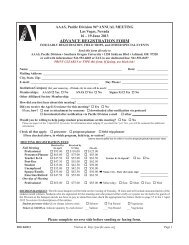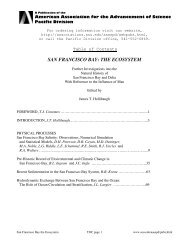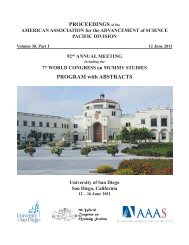Vol 31, Part I - forums.sou.edu ⢠Index page - Southern Oregon ...
Vol 31, Part I - forums.sou.edu ⢠Index page - Southern Oregon ...
Vol 31, Part I - forums.sou.edu ⢠Index page - Southern Oregon ...
You also want an ePaper? Increase the reach of your titles
YUMPU automatically turns print PDFs into web optimized ePapers that Google loves.
ABSTRACTS – Symposia<br />
in the presence of numerous inhibitors that target host cell<br />
signaling proteins. We then measured the number of host<br />
cell-internalized bacteria and levels of IL-8 secreted into the<br />
supernatants.<br />
We found that many of the host cell proteins required for<br />
C. jejuni internalization and the IL-8 inflammatory response<br />
are the same (i.e., EGFR, FAK, Src, PI 3-kinase). We also<br />
identified a C. jejuni secreted protein, which we termed CiaD,<br />
that activates the mitogen-activated protein kinase (Erk 1/2)<br />
pathway necessary for the secretion of IL-8 from epithelial<br />
cells. These findings are consistent with the proposal that the<br />
C. jejuni Cia proteins promote intracellular signaling leading<br />
to bacterial uptake and the release of the pro-inflammatory<br />
cytokine IL-8.<br />
85 Effects of Selective and Non-selective NSAIDs on Initiation,<br />
Progression and Antibiotic Efficacy of Experimental<br />
Group A Streptococcal Myonecrosis, Stephanie Ham-<br />
ILTON 1,2 *, Clifford R Bayer 1 , Dennis L Stevens<br />
1,3 , and Amy E Bryant 1,2,3 ( 1 U.S. Department<br />
of Veterans Affairs Medical Center, 500 West Fort Street,<br />
Boise, ID 83702; 2 University of Idaho, Department of Life<br />
Sciences, PO Box 443051, Moscow, ID 83844-305; 3 University<br />
of Washington School of Medicine, 1959 NE Pacific<br />
Street, Seattle WA 98195; hamilton.steph@yahoo.com).<br />
Background: NSAIDs may worsen group A streptococcal<br />
(GAS) disease yet some advocate NSAIDs to treat<br />
bacterial infection. We examined the effects of selective<br />
and non-selective NSAIDs, alone and with antibiotics, on<br />
initiation of post-injury GAS muscle infection and on survival<br />
of mice with GAS myonecrosis. Methods: Wild-type<br />
or COX-2 -/- mice underwent standardized hindlimb muscle<br />
injury. NSAIDs were given 47 hr post-injury and 1 hr prior<br />
to IV M-type 3 GAS. GAS in muscles, blood and spleen was<br />
quantitated 6 hrs later. In separate studies, mice were infected<br />
IM with LD 100<br />
GAS. NSAIDs and/or antibiotics (penicillin,<br />
clindamycin) were given every 8-12 h for 72 hr. Survival was<br />
followed for 14 d. Results: The non-selective NSAID significantly<br />
increased GAS infection of injured muscle in only<br />
wild-type mice. Pharmacologic inhibition, but not genetic<br />
deletion, of COX-2 r<strong>edu</strong>ced the systemic bacterial burden<br />
below the muscle infection threshold. In established myonecrosis,<br />
non-selective and COX-2-selective NSAIDs significantly<br />
accelerated the time to death and greatly r<strong>edu</strong>ced antibiotic<br />
efficacy. Conclusions: We conclude that use of certain<br />
NSAIDs, either alone or as adjuncts to traditional antibiotic<br />
therapy, for suspected or established GAS infection is not<br />
prudent and may, in fact, contribute to worse outcomes in<br />
severe GAS infection.<br />
86 Modeling HIV-1 Latency in Primary Central Memory Lymphocytes,<br />
Laura MARTINS*, ALBERTO Bosque,<br />
Marylinda Famigletti, Peter Ramirez,<br />
Camille Novis, and VICENTE Planelles<br />
(Division of Microbiology and Immunology, Department of<br />
Pathology, University of Utah, 15N Medical Dr., Salt Lake<br />
City, UT, 84112; laura.martins@path.utah.<strong>edu</strong>).<br />
Central memory CD4+ T lymphocytes (T CM<br />
) harbor the<br />
majority of latent HIV-1 proviruses in vivo. We have developed<br />
a latency assay based on cultured T CM<br />
cells to characterize<br />
biological processes important in the establishment<br />
and maintenance of HIV-1 latency. Using this model, we<br />
have characterized the effects of antigenic stimulation and<br />
homeostatic proliferation induced by cytokines on the latent<br />
reservoir. Antigenic stimulation through the TCR and the<br />
subsequent activation of the Lck/calcineurin/NFAT pathway<br />
reactivates virtually all latently infected cells, and successfully<br />
depletes the reservoir, but would result in cytokine<br />
storm if used in vivo. IL-2+IL-7 cytokine stimulation reactivates<br />
latently infected cells, albeit infefficiently, with concomitant<br />
expansion of the latent reservoir via homeostatic<br />
proliferation. Because both of these options are therapeutically<br />
untenable, we <strong>sou</strong>ght alternate approaches for reactivation<br />
of latent HIV-1.<br />
We adapted our published HIV-1 latency model for high<br />
throughput screening of compounds with the ability to reactivate<br />
latent HIV-1. One such compound, denoted “C7”, is<br />
capable of viral reactivation within 80% of latently infected<br />
cells, without global T cell activation. This result demonstrates<br />
the existence of alternative signaling pathways leading<br />
to activation of latent proviruses in primary cells. Key<br />
signaling elements controlling these pathways should be<br />
considered as novel therapeutic targets.<br />
Recent Advances in<br />
Pharmacology and Toxicology<br />
Wednesday, 8:30 a.m. in PAYETTE RIVER<br />
87 Inhibition of Growth of Cervical Cancer Cells by a<br />
Chymotrypsin-Like Protease Inhibitor, KIMBERLY J<br />
JURGENSEN*, KRISTIN A ECKERT, and GARY A<br />
CLAWSON (Jake Gittlen Cancer Research Foundation,<br />
Pennsylvania State University College of Medicine, H059,<br />
500 University Drive, Hershey, PA 17033; kim_jduncan@<br />
hotmail.com).<br />
The chymotrypsin-like serine protease inhibitor, succinyl-alanine-alanine-proline-phenylalanine<br />
chloromethyl<br />
ketone (AAPF CMK<br />
), has been shown to significantly inhibit<br />
the growth of tumorigenic human papillomavirus (HPV)-<br />
infected keratinocytes in organotypic raft cultures.. . We<br />
hypothesized that AAPF CMK<br />
treatment arrests the growth<br />
of the HPV-16 infected cervical cancer cell lines, SiHa and<br />
CaSki, by blocking the ability of the HPV-16 E6 and/or E7<br />
oncoproteins from interacting with the tumor suppressor proteins,<br />
p53 and pRb, respectively...The effects of AAPF CMK<br />
treatment on cellular growth, cell cycle kinetics, DNA synthesis,<br />
and p53 and pRb expression levels were examined in<br />
72








